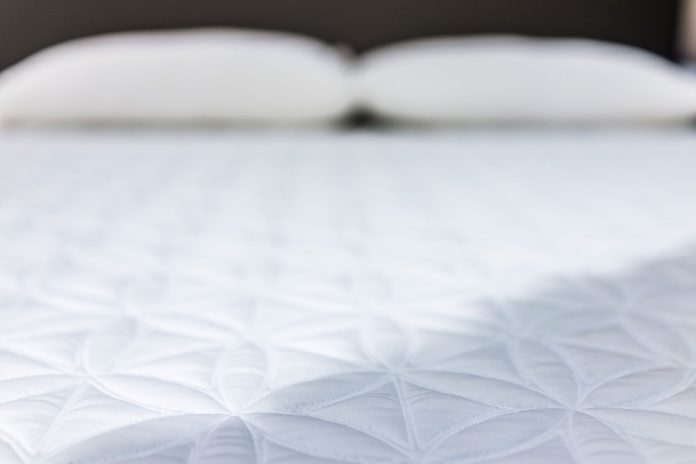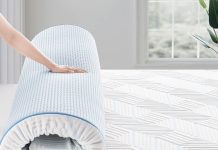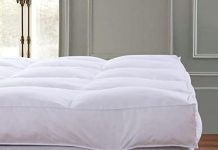Are you tired of waking up with an itchy nose and watery eyes? We’ve got the solution for you – cleaning mattress dust mites! These pesky little creatures can wreak havoc on your sleep and overall well-being but fear not because we have some simple and practical tips to help you get rid of them for good. Say goodbye to sneezing fits and hello to a clean and healthy mattress that will give you the best night’s sleep you’ve ever had!
Review contents
Removing Dust Mites From Mattress
Vacuuming Your Mattress
One of the most effective ways to remove dust mites from your mattress is by regularly vacuuming it. We recommend using a vacuum cleaner with a high-efficiency particulate air (HEPA) filter to capture and contain the dust mites and their allergens effectively. Start by removing all bedding and linens from the mattress and then thoroughly vacuum the entire surface, paying particular attention to the seams, edges, and corners. Use the upholstery attachment or a soft brush to gently cover the surface and remove as much debris as possible.
Using Steam Cleaning
Another method to eliminate dust mites from your mattress is by using steam cleaning. Steam cleaning kills dust mites and sanitizes the mattress, removing any odors or stains. You will need a handheld or a steam vacuum cleaner to do this. Fill the machine with water, heat it, and slowly move the steam nozzle over the entire mattress surface. Be sure to cover all areas, including the seams and edges, to ensure thorough cleaning and killing of dust mites.
Freezing the Mattress
Did you know that freezing your mattress can help kill dust mites? While it may not completely eradicate them, it can reduce their population. To freeze your mattress, wrap it in a plastic cover or a zippered mattress protector and place it in a large freezer for at least 24 hours. The low temperatures will effectively kill most dust mites and their eggs. After freezing, allow the mattress to thaw completely before using it again.
Utilizing UV Light Treatment
UV light can be an effective tool in killing dust mites and other allergens present in your mattress. UV-C light has germicidal properties that can penetrate the outer cell membranes of dust mites and disrupt their DNA, effectively killing them. Specialized UV light devices designed for mattress treatment emit the appropriate wavelength of UV-C light. Follow the manufacturer’s instructions and ensure you cover all areas of the mattress for optimal results. Wear protective eyewear and follow safety guidelines when using UV light devices.
Using Mattress Encasements
Investing in mattress encasements can be a great long-term solution to prevent dust mite infestations. Mattress encasements are specially designed covers that fully enclose your mattress as a barrier between you and the dust mites. These covers are usually made of tightly woven fabric that prevents dust mites from penetrating and eventually reaching the surface of the mattress. Ensure you choose encasements that are labeled as allergen-proof and have been tested for effectiveness. Additionally, regularly washing the encasements is crucial to maintaining their efficacy in keeping dust mites at bay.
Washing Bedding and Linens
Hot Water Washing
One of the easiest and most effective ways to remove dust mites from your bedding and linens is by washing them in hot water. Dust mites cannot survive high temperatures, so washing your items in water at a temperature of 130°F (54°C) or above will effectively kill these microscopic pests. Be sure to check the care instructions on your items to ensure they are suitable for hot water washing. Use a mild detergent and a gentle cycle to avoid damaging the fabrics, and consider adding an extra rinse cycle to remove any remaining allergens.
Adding Allergen-Reducing Additives
To enhance the effectiveness of the washing process, you can add allergen-reducing additives to your laundry. Commercially available laundry additives are designed to neutralize and eliminate dust mite allergens. These additives often contain enzymes that break down the allergens, rendering them harmless. Follow the instructions on the product packaging and add the recommended amount of the additive to the detergent compartment before starting the wash cycle.
Using Sodium Percarbonate
Sodium percarbonate, a compound made of sodium carbonate and hydrogen peroxide, is a powerful cleaning agent that can be used to remove dust mites from bedding and linens. It acts as a natural bleach and disinfectant, killing dust mites and removing stains and odors. To use sodium percarbonate, add it to your laundry along with your regular detergent. Follow the instructions on the packaging for the appropriate dosage, and let the solution soak for a while before starting the wash cycle.
Drying at High Heat
After washing your bedding and linens, it is essential to dry them thoroughly to eliminate any remaining dust mites. Use a dryer to a high heat setting to ensure the temperature is sufficient to kill the mites. If the fabric permits, consider adding dryer sheets or sachets containing essential oils known for their antimicrobial properties, such as tea tree oil or eucalyptus oil. These oils add a pleasant scent to your laundry and help eliminate any lingering dust mites.
Cleaning the Bedroom Environment
Regularly Vacuuming the Bedroom
In addition to vacuuming the mattress, it is essential to vacuum the entire bedroom regularly to minimize dust mite populations. Dust mites thrive in carpets, upholstery, and other soft surfaces, so using a vacuum cleaner with a HEPA filter to remove dust and allergens is essential. Be sure to vacuum all floor surfaces, curtains, blinds, and upholstered furniture. Pay attention to areas where dust accumulates, such as corners, baseboards, and underneath furniture.
Dusting Surfaces
Regular dusting can significantly reduce the number of dust mites in your bedroom. Use a damp cloth or a microfiber duster to capture the dust and prevent it from becoming airborne—dust all surfaces, including dressers, nightstands, bookshelves, and light fixtures. Don’t forget to dust any decorative items and picture frames as well. It is advisable to start from the top of the room and work your way down to prevent dust from settling on already-cleaned surfaces.
Controlling Humidity
Dust mites thrive in environments with high humidity, so controlling the humidity level in your bedroom can help prevent infestations. Aim for a humidity level between 30% and 50%. You can use a dehumidifier to remove excess moisture from the air or use an air conditioner to cool and dehumidify the room. Additionally, avoid hanging wet clothes or towels in the bedroom and ensure proper ventilation by opening windows or using a fan.
Reducing Clutter
Clutter provides hiding places for dust mites and makes cleaning more challenging. Keep your bedroom tidy and minimize clutter by regularly decluttering and organizing. Remove unnecessary items from surfaces and store belongings in closed containers or drawers. Avoid accumulating excessive pillows, stuffed animals, or other items that collect dust. The less clutter you have in your bedroom, the easier it will be to clean and maintain a dust-mite-free environment.
Avoiding Carpeted Floors
Carpeted floors can harbor dust mites, making keeping your bedroom free from these pests more difficult. Opt for hard flooring surfaces, such as hardwood, laminate, or vinyl, which are easier to clean and less hospitable to dust mites. If you have carpeting, vacuum it regularly with a HEPA filter vacuum cleaner and consider steam cleaning it periodically to eliminate dust mites and allergens.
Preventing Dust Mite Infestations
Utilizing Allergen-Proof Bedding Covers
Prevention is vital when it comes to dust mites. Utilize allergen-proof bedding covers, such as mattress encasements and pillow protectors, to create a barrier between you and the dust mites. These covers are designed to prevent dust mites from colonizing your bedding, helping reduce allergen exposure. Ensure the covers are zippered and made of a tightly woven fabric to block mites and their allergens effectively.
Washing Bedding Regularly
Regularly washing your bedding is essential in preventing dust mite infestations. Aim to wash your sheets, pillowcases, and blankets in hot water at least once a week. This will remove any existing dust mites and prevent their population from multiplying. Remember to follow the guidelines mentioned earlier for hot water washing and consider adding allergen-reducing additives to enhance the cleaning process further.
Changing Pillowcases Frequently
Pillows, specifically pillowcases, are common breeding grounds for dust mites. The accumulation of dead skin cells, oils, and moisture creates an ideal environment for dust mites to thrive. To minimize dust mite populations, change your pillowcases at least once every two to three days. This frequent change will help reduce the number of dust mites and limit allergen exposure during sleep.
Keeping Pets Out of the Bedroom
Pets often carry dust mites and their allergens on their fur, making them potential sources of infestation. Keeping pets out of the bedroom is advisable to minimize dust mite exposure. If you allow your pets on the bed, ensure that they have clean bedding that is regularly washed. Consider providing them with a cozy sleeping area in another part of the house to prevent dust mites from spreading to your bedroom.
Maintaining Good Ventilation
Proper ventilation is crucial in creating an unfavorable environment for dust mites. Ensure good airflow in your bedroom by opening windows during the day and using fans or air purifiers to circulate the air. This helps to reduce humidity and prevent the accumulation of dust mites. Additionally, periodically airing out mattresses, pillows, and bedding can help eliminate trapped moisture, keeping dust mites at bay.
Natural Remedies to Clean Mattress Dust Mites
Essential Oils
Essential oils are known for their natural antimicrobial properties and can be used as a natural remedy to help eliminate dust mites from your mattress. Tea tree oil, eucalyptus oil, and lavender oil are particularly effective in killing these pests. To utilize essential oils, dilute a few drops in water and spray the solution onto the mattress. Alternatively, add a few drops to your laundry when washing bedding and linens. Not only will these oils help get rid of dust mites, but they will also leave a pleasant scent in your bedroom.
Baking Soda
Baking soda is a versatile and inexpensive natural remedy that can be used to clean and deodorize your mattress. It can absorb moisture and neutralize odors, making it a valuable tool in the fight against dust mites. Sprinkle a generous amount of baking soda over the entire surface of the mattress and let it sit for several hours or overnight. Vacuum the baking soda thoroughly to remove it, along with any trapped dust mites and their allergens.
Lavender Sprays
Lavender is not only known for its calming scent but also for its dust mite-repellent properties. Creating a homemade lavender spray can help keep dust mites at bay. Fill a spray bottle with water and add a few drops of lavender essential oil. Shake well before using it, then lightly mist your mattress, pillows, and bedding with the lavender spray. This will freshen up your bedding and act as a natural deterrent for dust mites.
Diatomaceous Earth
Diatomaceous earth is a natural and non-toxic powder made from the fossilized remains of marine phytoplankton. It can be used to eliminate dust mites from your mattress effectively. Sprinkle a thin layer of food-grade diatomaceous earth onto the mattress and gently work it into the fabric using a soft brush or broom. Let it sit for a few hours or overnight, and then vacuum it thoroughly to remove the powder and the dead dust mites.
Seeking Professional Help
Hiring Professional Mattress Cleaning Services
If you cannot effectively remove dust mites from your mattress using the methods above, it may be time to seek professional help. Professional mattress cleaning services have specialized equipment and expertise to thoroughly clean and sanitize your mattress, eliminating dust mites and allergens. Research and choose a reputable service provider with positive reviews and experience dealing with dust mite infestations.
Using Mattress Sanitizing Equipment
Mattress sanitizing devices are available for those who prefer a DIY approach but want similar results to professional cleaning. These devices use UV light, steam, or a combination of both to kill dust mites and sanitize the mattress. Ensure you carefully read and follow the instructions provided with the device to achieve the desired results. It is important to note that the effectiveness of these devices may vary, so thorough research is recommended before purchasing.
Conclusion
Ensuring a dust-mite-free mattress and bedroom environment is crucial for individuals with allergies or asthma. Following the tips and methods outlined in this comprehensive article, you can effectively remove dust mites from your mattress and prevent future infestations.
From vacuuming and steam cleaning to using natural remedies and seeking professional help, various approaches depend on your preferences and needs. Remember to maintain regular cleaning habits, wash bedding frequently, and create a clean and clutter-free sleeping environment to keep dust mites at bay.
























